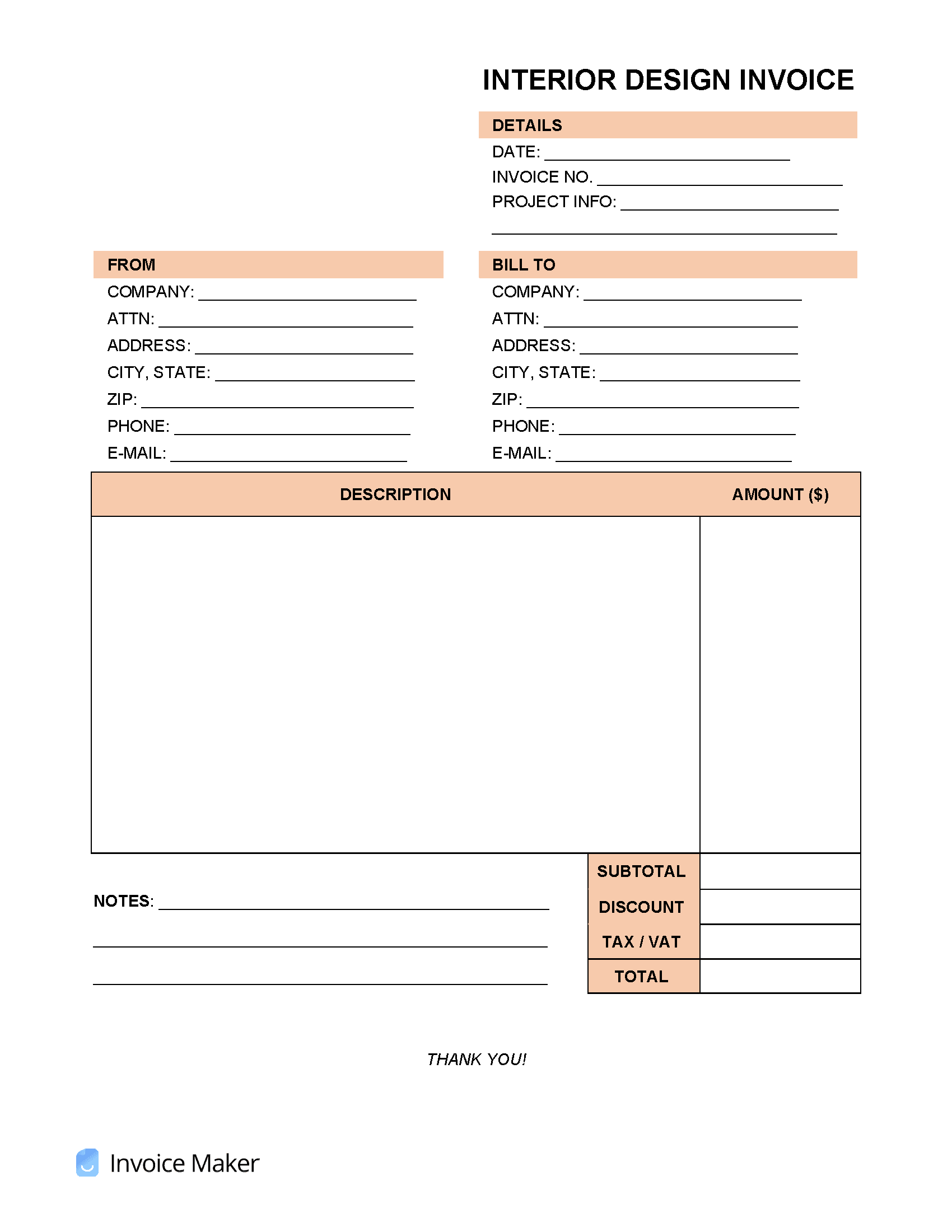Interior Design Invoice Template
An interior design invoice is a document used to itemize and bill the labor and material costs associated with interior design services. Interior designers charge for their services on an hourly basis but frequently need to buy furniture, decorations, and other materials, as well as hire contractors to make significant changes to the layout of spaces, so the invoice should reflect all relevant charges.

How to Create an Invoice for Your Interior Design Services
Interior design invoices are the means by which interior designers charge clients for the time, effort, and expertise they spend beautifying a house, kitchen, bathroom, living space, bedroom, office, or any other interior space. The invoice can be created using a variety of software programs, or created manually using a program like Microsoft Excel. It is generally best to send invoices electronically, as this allows for easy tracking and eliminates the need for paper records. Interior design invoices should be clear and concise and should include all relevant information. Interior design invoices can be paid via check, credit card, or bank transfer.
What is Interior Design?
Interior design is the process of planning and improving the interiors of residential and commercial dwellings both large and small to create a more pleasant and functional atmosphere for those that occupy the buildings. The profession is closely associated with architecture and has seen an increase in popularity in modern times. With colors, textures, materials, lighting, and furniture, interior decorators can make a single room evoke a myriad of emotions and feelings.
Types of Interior Design
The styles of interior design can vary widely, as what is considered “modern” is likely to be considered outdated later. According to award-winning decorators Rochele Decorating, the most common styles (types) of interior design are as follows:
- Modern – Clean looking with non-complex colors. Utilizes metal, glass, and steel.
- Contemporary – Not adherent to an exact style; can include curvature in designs.
- Minimalist – Simple, non-flamboyant, and functional.
- Industrial – “Unfinished” look; exposed decor, high ceilings, and functional furniture.
- Mid-Century Modern – Retro + minimalism; popular style in the ’50s and ’60s.
- Scandinavian – Natural materials, spacious, and art-influenced.
- Traditional – Classic design, lots of accessories, with a dark color palette.
- Transitional – The combination of modern and traditional styles.
- French Country – Worn wood furnishings and soft + warm colors.
- Bohemian – Non-binding style; allows for freedom of expression. Random and carefree.
- Rustic – Makes use of wood, stone, and other “outdoorsy” materials.
- Shabby Chic – Characterized by soft, feminine, and light-colored fixtures and furniture.
- Hollywood Glam – Luxurious and dramatic; utilizes plush and velvet materials.
- Coastal / Hamptons – Inspired by the ocean; light colors and liberal use of wood.
Styles can differ from location to location and based on a designer’s training and taste, so the above shouldn’t be used as anything more than a general reference.
What Education is Required for Interior Design?
Obtaining formal education is not necessarily a requirement for becoming an interior designer but can lead to an increased salary (or reasoning for charging a higher hourly rate). Both associate’s and bachelor’s degree programs can provide students with the necessary knowledge to serve clients, with certifications being an option after completing advanced schooling.
Interior Designer Salary & Hourly Rate ($/hr)
Salary: $89,040/yr (source: Glassdoor) Hourly Rate: $24.74/hr (source: Payscale)
Key Features of an Interior Design Invoice
- Designer’s name and contact information (address, phone number, email)
- Designer’s logo if applicable
- Client’s name and contact information (address, phone number, email)
- Date of invoice
- Description of services provided
- Time it took to complete each service
- Total for all services/labor
- Descriptions of furniture, materials, and supplies being charged
- Price of each item
- Total of all materials/furniture
- Grand total
- Applicable taxes
- Payment methods
- Due date of payment
When it comes to making your interior design invoice look professional, there are a few key things you can do to set yourself apart from the competition. First, be sure to use a clean and modern design for your invoice template. This will give your invoice a professional appearance and help it to stand out from the rest. Secondly, be sure your invoice includes all of the above elements.
Common Mistakes on an Interior Design Invoice
1. Not itemizing all charges. When creating your interior design invoice, be sure to itemize every charge so your client knows exactly what they are paying for. This includes listing the quantity and cost of each item, as well as any labor charges. 2. Not including a payment schedule. Your invoice should always include a payment schedule so your client knows when they need to pay each invoice. This helps to prevent confusion and late payments. 3. Not making sure your pricing is accurate and up-to-date. Even when you are an established designer, it’s a good idea to stay abreast of the market and what other designers are charging. 4. Charging for extras that were not discussed with the client. This is a surefire way to lose a long-term client.